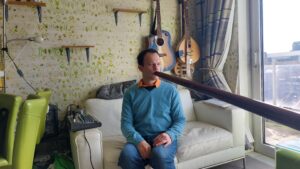The didgeridoo
Lessons can be face to face or via Skype!
The didgeridoo or yidaki, is one of the oldest wind instruments that humankind has been playing. Its sound is bewitching and penetrates the listener with its bass sounds, throughout the whole body. Mike considers himself as a modern didgeridoo player, specialising in solo or meditative playing, and how to properly amplify it correctly the get the most out of its sound. Since 2012 I followed many workshops and had several great teachers such as Gauthier Aubé (Gregoire Van de Reykel), Ondrej Smeikal, Tom Fronza, Lies Beijerinck Tijs Logic and Dubravko Lapaine.
I live in Brussels, Belgium in the neighbourhood of the European Commission buildings and close to the Cinquantenaire park. In the lessons that I give, I try to explain using simple language that everybody can understand. Playing the didgeridoo requires 2 things: pushing the air (exhaling) and pulling the air (inhaling). Breathing is everything. As a beginner, we start with the drone, and exhale, making a buzzing sound. When it becomes more difficult, is when we start circular breathing, and we can inhale while playing. once we are able to play without stopping and that the sound is continuous, That is when the didgeridoo really starts to be fun.
After we learn the basics, then we begin to understand that actually, there are 3 different sounds we can produce when inhaling. They are called the wobble, the jaw breathing, and the throat breathing. Being able to master these 3 kinds of breathings take a long time and control and be aware of everything going on in the mouth. When gaining experience, the player realises that the didgeridoo can make 6 types of sounds: the drone, the voice, the harmonics, the toots, the drop octave and the flute sound. When the knowledge and the abilities increase, the didgeridoo player will have enough tools to play with an articulate sound and play with a soft and melodic sound or strong and percussive sound.
Once that is mastered, a didgeridoo player realises the importance of a precise, clear sound and well articulated. And to be able to play very slow, but also very fast. Also, as in sports, the player can increase his / her capacities, like speed or precision or power. Anyway, the road to mastery of the breath and of this instrument is never ending. As a teacher, Mike will listen to your playing, explain what you are doing, and guide you in the right direction. He will always find exercises to give you to help with whatever it is that you want to improve.
All didgeridoos have different sound qualities. The one that I use since 2017 is the hard fiberglass didgeridoo made by Andrea Furlan. It has amazing playability and my didgeridoo has a short bell (great for travelling) and a long bell (great for sound massages). In my opinion, and I have tried lots and lots of different ones from a great number of makers, the best are Duende didgeridoos.
You can register via the Apprentus website by following this link
Please subscribe to our social networks to support us and share and spread our music. You can also support us financially with tips on tipeee

